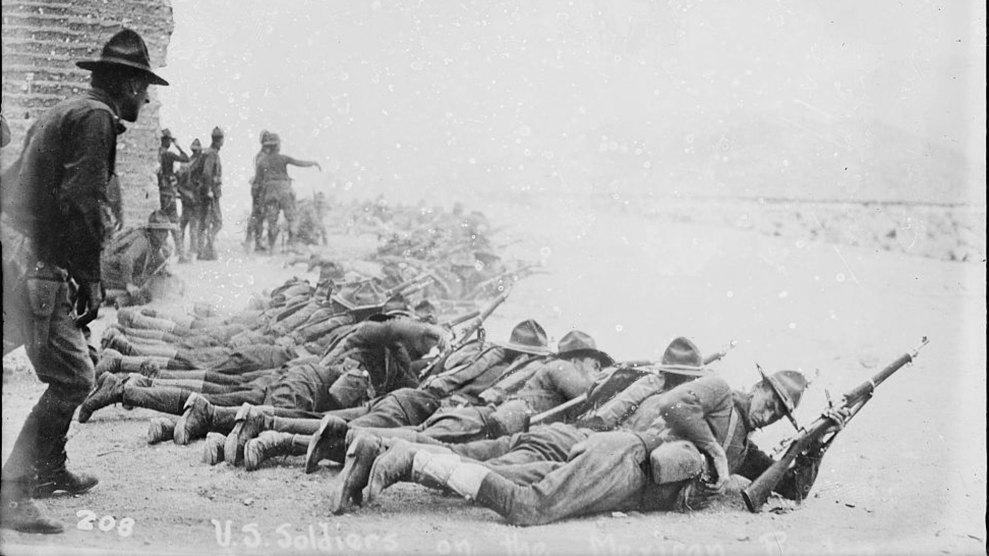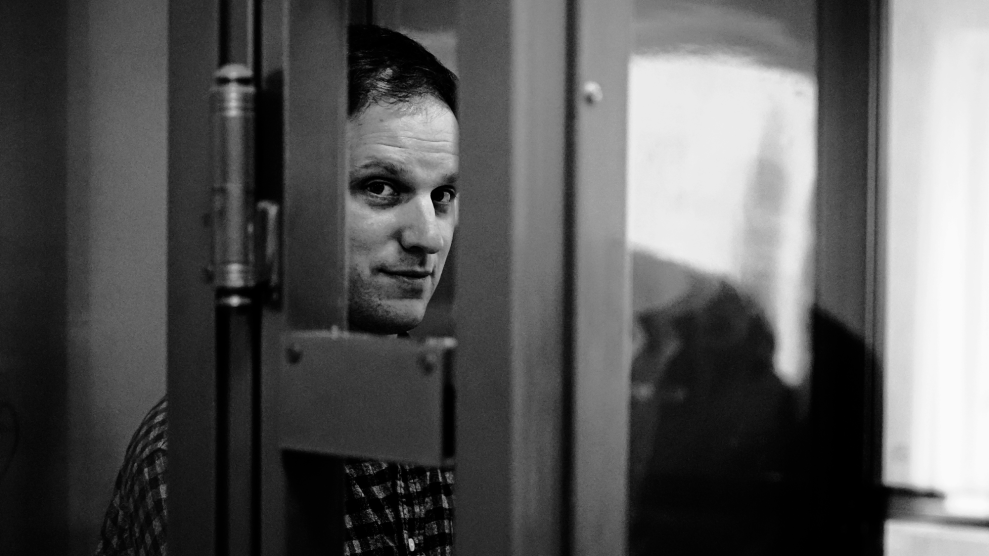
US soldiers on the Mexican border in 1915.Library of Congress
Antonio Rodriguez was burned at the stake. Jesus Bazan was shot in the back. Macedonia Herrera was executed on a hill overlooking his home. Between 1910 and 1920, historian Monica Muñoz Martinez writes in her new book, The Injustice Never Leaves You, somewhere between 300 and several thousand men and women of Mexican descent—many of whom were American citizens—were killed in a campaign of state-sanctioned terror across South and West Texas.
This campaign of violence, waged by vigilante posses, local law enforcement, the Texas Rangers, and the US Army, came at a time of intense agitation from white landowners, elected officials, and journalists over the threat of invading “bandits” crossing the border and preying on the population. The crackdown tore communities apart and transformed the nature of the border itself, from an open landscape freely crossed to a sharply defined militarized zone. The Army was deployed to the border in 1910, and 14 years later, Congress created the Border Patrol. The story of how the Mexican border came to be secured is a tragic one that has been largely forgotten in popular memory, but not by the families who lived it.
I spoke with Martinez in November, at a time when political fears about immigrants had once more led to a troop buildup in South Texas.
Mother Jones: When we talk about border violence in Texas during this period, what exactly are we talking about—who was being targeted and who was doing the targeting?
Monica Muñoz Martinez: In the early 20th century—between 1910 and 1920 especially—there were calls by politicians, by the media, by Anglo residents living near the US–Mexico border, for more policing. The criminalization of ethnic Mexicans was pervasive; people were identified as being “bandits” or sympathizing with the [revolutionary] efforts during the Mexican Revolution. Ethnic Mexicans, regardless of their citizenship or their nationality or their class, were portrayed as a threat to Anglo residents, to US citizens more broadly, and to the nation. As a result, vigilantes, Texas Rangers, the state police officers, local law enforcement, and US soldiers denied ethnic Mexicans due process and participated in this reign of terror where people were murdered, tortured, interrogated, and threatened.
MJ: Was this acknowledged at the time—was it understood that this was happening and that it was justified, or was it covered up?
MMM: The media coverage was complicated. On the one hand, you had media outlets, like the San Antonio Express-News, that would publish newspaper articles describing scenes where bodies of Mexican men were found on the side of the road, but they also—and sometimes in the same article—would say this is so common now, it’s not even newsworthy, so we’re going to stop reporting on it. In South Texas, you had a mix of English-language newspapers in towns like Brownsville or Laredo that were writing about what was taking place, and you also had Spanish-language newspapers. You had these competing accounts of what was taking place.
Photographers circulated very casually these photographs of dead Mexican men, and they were criminalized and labeled as “bandits.” The English-language press had a big part in creating the justification for violence. If they did account for a Texas Ranger shooting somebody, they didn’t call for an investigation into the murder. They would celebrate it.
MJ: So a lot of the violence was amplified by the media.
MMM: Absolutely. What was quite common were these sensational accounts that criminalized the victim and celebrated the bravery either of mobs, or of the law enforcement officers, or of the US soldiers that were participating. Those sensational accounts were also picked up in news outlets like the New York Times and across the country that were giving people across the nation a particular understanding of what was happening at the border. What became widespread was the figure of the Mexican threat—Mexican men were portrayed as bandits and portrayed as criminals. That became popularized in this era.
MJ: Even the New York Times?
MMM: Yes, and when you think about the ways that the media was portraying the militarization, this was nation-building in an important way. Readers across the country were learning about these US soldiers that were being sent to patrol the border and secure the border. Photographers were taking photographs of soldiers learning to use the newest military technologies. On the one hand, it was a way of promoting US military might—that soldiers were prepared to be deployed for World War I. On the other hand, it also fit into this effort to actually create a border between the United States and Mexico.
In the early 20th century the border didn’t exist as it does now; people moved back and forth fluidly. People lived on one side or had property on one side of the border and worked on the other side of the border. There weren’t immigration restrictions as we understand them to exist today. So there was this effort by Anglo residents in South Texas to disrupt that and to actually create a clear dividing line between South Texas and Mexico. The militarization of the border played into a larger national conversation about what the border should look like and how to create one.
MJ: Secretary of Defense James Mattis invoked this era recently when he talked about Pancho Villa’s “raiding” as a parallel for the current mission on the border. What did you think when you heard that?
MMM: I was glad to see that journalists and people across social media quickly criticized Mattis for this misleading history lesson—likening refugees who were traveling to the United States to seek asylum to armed revolutionary troops. That is just so inaccurate. But the press largely left the militarization of the border 100 years ago unquestioned, falling back in line with, “Yes, there was banditry and the border was un-secure and people needed to be defended.”
What actually took place is that you had US soldiers participating in these acts of racial terror. They were shooting people as they were crossing the border. One of the accounts in the book is of Concepcion Garcia, a little girl who was a student in Texas who was traveling back to Mexico with her mother, and they were shot at by a US soldier. That soldier was not prosecuted or dismissed from the military. The colonel who was in charge of the military district in West Texas was very bold in saying that his role and his orders were to pursue criminals on either side of the river and to exterminate this threat.
MJ: He used the word “exterminate”?
MMM: Yes, one of the quotes that I have in the book is that the orders that he had were to “pursue criminals on either side of the river until they are exterminated.”
MJ: Wow.
MMM: What people largely think when they think of Pancho Villa is that the US soldiers were making sure that people weren’t crossing into the United States. What they miss is that the US soldiers and Texas Rangers were not just policing people crossing from Mexico, but they were policing anybody who looked Mexican. So when there was a raid, they participated in revenge by proxy; they murdered people in the proximity of the area. For example, [the colonel] saying “on both sides of the river” is an important historical lesson that we have to think about. When we have raids in communities with high Latino migrant populations in cities across the United States, you know, that creates terror and fear for anybody living in that neighborhood. The kinds of racial profiling that led to violence 100 years ago as a nation we still don’t have an understanding of.
MJ: There’s a chapter in the book on the massacre at Porvenir in West Texas in 1918, which killed 15 people. It’s a horrific story, and I’d never heard of it. Is that taught in Texas schools?
MMM: Not yet—I think that’s changing. What I’ve learned in my research is that when generations of families stay in the same local communities, then those accounts of what happened 100 years ago are preserved and circulated, normally in the privacy of people’s homes, but certainly not in a traditional classroom.
But on the whole, this period of violence is not taught or discussed publicly by cultural institutions, by history curriculums, because this is a period of state-sanctioned racial terror. It’s a difficult history because it shines a light on a period of Texas history where you had governors, state senators, US congressmen, calling for racial violence. And in a way that doesn’t just place blame on one or two Texas Rangers here and there, or a mob in a local community in this town, but actually thinks about state-sanctioned violence.
MJ: You were just at the unveiling earlier this month of a new historical marker for a lynching in South Texas.
MMM: I was in Hidalgo County for the unveiling ceremony of a Texas state historical marker that is documenting and commemorating the double murder of Jesus Bazan and Antonio Longoria in September 1915. The unveiling was the keystone event for that week, but we had a poetry reading, there was also an art exhibition, I gave a book talk, and we coordinated a training for university students so they could learn to conduct oral histories, but also learn how to digitize photographs and documents.
MJ: Who were Bazan and Longoria and what happened to them?
MMM: I make a clear, intentional point of trying to give access to the names of victims and to their families when I’m able to. It’s good historical work and practice, but it also is trying to do an important recovery effort, because that estimate of hundreds of ethnic Mexicans being murdered doesn’t give people access to what that loss meant for people at the time. It’s an anonymous number.
Bazan and Longoria were prominent residents of Hidalgo County. Longoria was a Hidalgo county commissioner, and he also had a teaching license. They were well-respected, they were well-known, and their murders were striking because they didn’t lead to any investigation. So here you have landed, well-known members of the community who were murdered and there was no investigation. The local police didn’t investigate. The Texas Rangers didn’t investigate. The media didn’t cover the double murder. It’s a really striking event because it gives you a sense of the lengths that these groups went to actually not leave a record.
It was very common for landowning families to be intimidated by these murders and to leave for safety. And in this case, [their wives], [Epigmenia] Bazan and [Antonia] Longoria, decided to stay with their families in Hidalgo and they maintained their property. Antonia Longoria later won an award for being part of a pioneering family and a contributor to the community in Hidalgo. So it’s this story of survival, but if you don’t know about the double murder, then it can just very easily be understood as the American Dream. This family had to continue. They found ways to survive in an extremely intimidating and violent era.
MJ: What’s the relevance of this now, in this current moment?
MMM: When I speak about injustice, it’s not just the murders that were not prosecuted. A part of the injustice is that there hasn’t been a truthful accounting of what took place. Historians have written about this period of violence. But these public cultural institutions have not participated in acknowledging this period of violence.
There’s the need to address this history and to have a public conversation about it, because that’s an important way of making progress and addressing the sense of inherited loss that people articulated to me when I was conducting my research. But the other part that’s important to learn from is that there are patterns. In this case, there are striking parallels between what happened a hundred years ago and the kinds of violence that are taking place today. We are living in the midst of another humanitarian crisis that is being fueled by political rhetoric that criminalizes racial and ethnic groups. Politicians are perpetuating the narrative that causes the public to turn a blind eye to violence.
I write about a refugee prison camp in West Texas in 1914 [at Fort Bliss]. Not far from Fort Bliss, Tornillo, the tent city prison camp for children, is growing. In some cases, this history and what’s happening today map onto the same locations.












